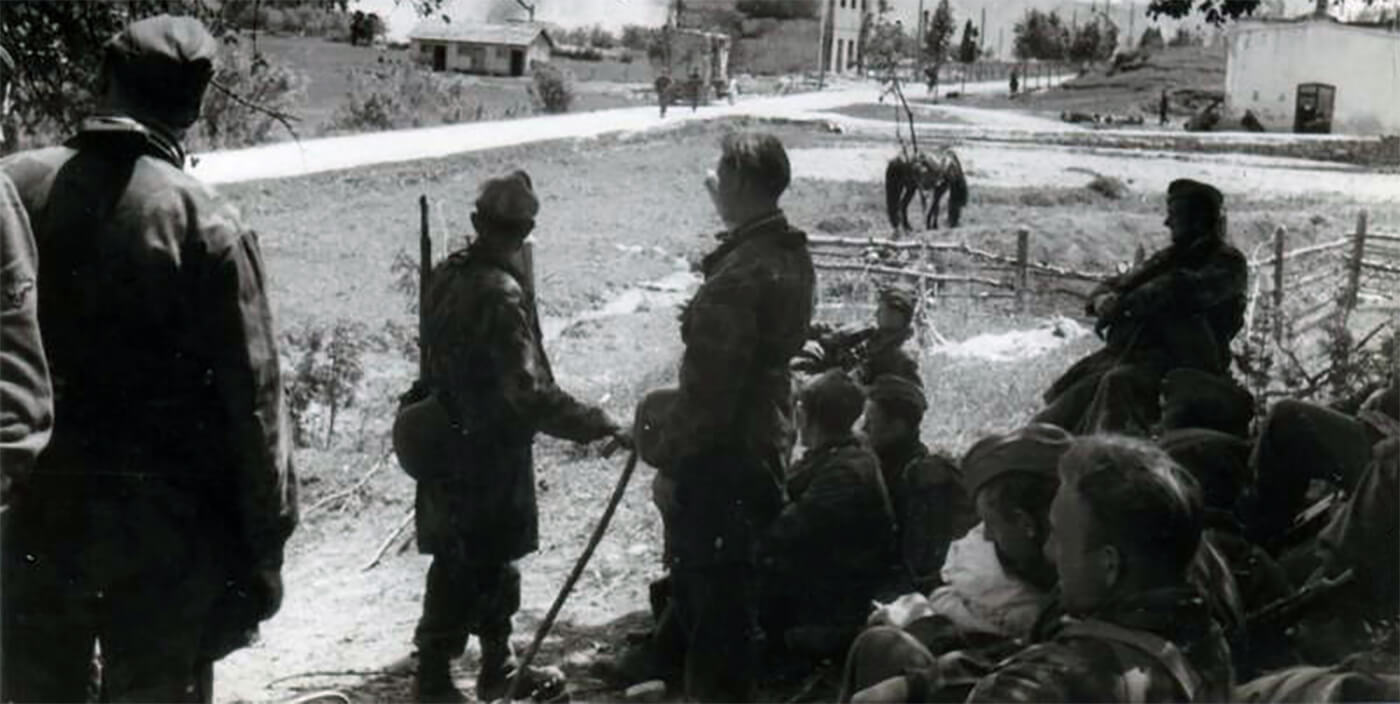| Page Created |
| August 28th, 2022 |
| Last Updated |
| September 13th, 2023 |
| Germany |
 |
| Additional Information |
| Unit Order of Battle Commanders Operations Equipment Multimedia Sources |
| Operations |
| Europe |
| March 19th, 1944 |
| Unternhemen Margarethe |
| SS-Fallschirmjäger-Bataillon 500 |
| It is not completely clear what the exploits of SS-Fallschirmjäger-Batallion 500 are during Unternehmen Margarethe. They are probably part of the XXII Gebirgs-Armeekorps (Hubert Lanz) that invades the country from Serbia and Slavonia. In the early hours, while the Hungarian delegation is returning, the German troops began their invasion. The involved units are the XXII Gebirgs-Armeekorps (Hubert Lanz) from Serbia and Slavonia, the LXIX Armeekorps (Ernst Dehner) from Croatia, the LVIII Reserve-Panzerkorps (Walter Krüger) from the Vienna area, and the LXXVIII Armeekorps z. b. V. from the Krakow area. Hermann Foertsch, Chief of Staff of von Weichs, coordinated the action from Vienna. The action is a complete surprise, proceeding swiftly with sporadic and limited resistance. Localised clashes with the advancing German forces occur, such as at the Danube bridge of Újvidek by the 16. Grenzjäger-Bataillon, resulting in the death of 26 German and one Hungarian soldier. Additional resistance was reported from Sopron, Győr, Székesfehérvár, and Ferihegy Airport. Approximately 50 German and 10 Hungarian soldiers were killed in the battles. Some German memoirs note being greeted with flowers. The operational orders included the disarming of the Hungarian army. Certain German units executed this order as they couldn’t be informed of the new situation in time. The Chief of the Hungarian Armed Forces, Ferenc Szombathelyi, who had been at Klessheim, instructed from the train to greet the Germans as allies. Horthy’s special train deliberately stopped several times on the return trip, so he was welcomed by a German honour formation upon his arrival in Budapest. |
| May 25th, 1944 – June 6th, 1944 |
| Unternehmen Rösselsprung |
| Fallschirmjäger, Sonderverband z.b.V. Friedenthal, SS-Fallschirmjäger-Bataillon 500, |
| Unternehmen Rösselsprung, was a military operation planned and executed by Nazi Germany. The mission of the operation was capturing or killing the Yugoslav Partisan leader, Josip Broz Tito, as well as disrupting the Partisan forces in Yugoslavia. The operation involved a massive airborne assault, with SS-Fallschirmjäger being dropped behind enemy lines to seize key strategic points and secure the area for the subsequent ground forces. However, the operation failed due to a combination of factors, including poor planning, intelligence leaks, and effective resistance by the Partisan forces. The failure of Unternehmen Rösselsprung represented a significant setback for the German war effort in Yugoslavia and highlighted the resilience of the Partisan forces. |
| July 1944 |
| Lithuanian Fire Brigade |
| SS-Fallschirmjäger-Bataillon 500 |
| Fallschirmjäger-Bataillon 500 holds a critical defensive position within the Vilnius Pocket. This strategic enclave, located in the Lithuanian capital of Vilnius, witnessed a fierce siege by Soviet forces during an offensive campaign that unfolded from July 5th to 13th, 1944. Numerous units from both the Wehrmacht and Waffen-SS found themselves encircled within this fortified area, which the Germans designated as “Fester Platz” or Fortress. Among these trapped units was the SS-Fallschirmjäger-Bataillon 500, contributing to the intense battles and crucial defense during this period. |
| October 15th, 1944 – October 16th, 1944 |
| Unternehmen Panzerfaust/Eisenfaust |
| SS-Fallschirmjäger-Bataillon 600, SS-Jäger-Bataillon 502 |
| Unternehmen Panzerfaust a.k.a. Unternehmen Eisenfaust. Their mission is kidnapping of Miklós Horthy Jr. to force his father, Admiral Miklós Horthy, to resign as Regent of Hungary in favor of Ferenc Szálasi, the pro-Nazi leader of the Arrow Cross Party. The operation was under the leadership of Hungarian Höhere SS- und Polizeiführer Otto Winkelmann. The SS-Fallschirmjäger-Bataillon 600 and SS-Jäger-Bataillon 502 flew to Hungary and captured the country’s leader, Admiral Miklós Horthy, his son and captured the Buda Palace in Budapest. The operation resulted in the establishment of a puppet government in Hungary, which remained in power until the end of the war. The operation was seen as a significant success for the Nazis and demonstrated their willingness to use covert operations to achieve their goals. |
| December 16th, 1944 – December 28th, 1944 |
| Unternehmen Greif |
| 150. Panzer Brigade Einheit Stielau, SS-Fallschirmjäger-Bataillon 600, SS-Jagdverbände |
| Unthernehmen Greif is a German military special forces operation during Unternehmen Wacht am Rhein, led by Otto Skorzeny. There are two goals in the operation. The main goal is to capture at least two of the bridges across the river Meuse. The second goal of the operation is infiltrating German soldiers disguised as American troops behind enemy lines. The mission area is the Malmedy area, Ardennes, Belgium. The start of Unternehmen Greif on December 16th, 1944, faces immediate challenges as Panzer-Brigade 150 becomes entangled at a blown-up bridge near Losheim. The brigade struggles to maintain its intended position and execute surprise actions due to congestion and chaotic traffic. On December 17th, 1944, Skorzeny attends a staff conference and proposed combining his battle groups into a conventional army unit, which is accepted. Panzer-Brigade 150 is assigned to capture the strategic road junction in Malmedy, known as “Rollbahn C,” to flank American positions on the Elsenborn ridge and support the 12. SS-Panzer-Division and Kampfgruppe Peiper. Skorzeny relies on information gathered by a commando team accidentally entering Malmedy, unaware that the town’s defense has been reinforced with additional American units and prepared obstacles like bridges, viaducts, and minefields. On December 20th, 1944, Kampfgruppe X and Kampfgruppe Y of Operation Greif assemble near Ligneuville, while Kampfgruppe Z remains in reserve. Otto Skorzeny devises a two-pronged attack plan, but their chances of surprise are ruined when one of their men was captured and revealed the planned attack. American Intelligence issues a warning about the impending attack. On December 21st, 1944, Kampfgruppe X launches their assault from Ligneuville towards Malmedy. However, they trigger a tripwire, exposing their position, and face heavy resistance from American defenders. The assault eventually subsides with heavy casualties and retreat. Throughout the day, American artillery barrages intensified. The fighting continues, but Panzer-Brigade 150 regroups on a hill south of the Warche valley. Skorzeny himself suffers a shrapnel injury to his face. On December 22nd, 1944, Kampfgruppe Y attempts another attack east of Malmedy but is forced to retreat due to prepared American outposts. The 291st Engineers demolishes bridges, effectively blocking the road west of Malmedy. The situation remains tense as further demolitions are carried out by American forces. Panzer-Brigade 150 continues to hold the line until it is relieved by elements of the 18. Volksgrenadier-Division. Meanwhile, during Unternehmen Greif, Otto Skorzeny dispatches lead, reconnaissance and demolition commando teams behind enemy lines. They operate in German uniforms and carry out various tasks. Some teams alter road signs to misdirect American troops, while others gather intelligence and spread false information. Skorzeny’s commandos successfully causes confusion and paranoia among American forces. They create doubt about the security of passwords and prompt increased caution at checkpoints. Rumours of a large German paratrooper unit heading to capture General Eisenhower causes anxiety and resulted in Eisenhower being relocated. Unfortunately, the chaotic nature of the Battle of the Bulge leads to tragic incidents of friendly fire. Confusion, mistaken identities, and the fast-paced nature of the battle contributed to these accidents. Incidents occurred where American soldiers mistakenly engaged and harmed their fellow comrades. These incidents continued into early 1945, further highlighting the challenges and risks posed by the presence of Skorzeny’s commando units during the battle. |
| February 1st, 1945 – March 3rd, 1945 |
| Schwedt Bridgehead |
| SS-Fallschirmjäger-Bataillon 600, SS-Jagdverbände |
| Otto Skorzeny receives orders to establish a defensive bridgehead at Schwedt on the Oder River, a short distance west of Konigsberg. Skorzeny embarked on this mission from Friedenthal. Upon reaching Schwedt, he discovers that, in addition to the SS-Fallschirmjäger-Bataillon 600 and SS-Jagdverbände unit already under his command, he has to confront the Soviet Army with only a battalion of pioneers and three severely undermanned battalions of elderly reservists. During this time, the roads are congested with civilian refugees fleeing the advancing Soviets and a considerable number of soldiers from fragmented units attempting to retreat westward. Skorzeny deploys reconnaissance platoons across the Oder River’s east bank and orders his troops to secure exit routes from Königsberg. They provide safe passage for both civilian and military personnel, escorting them to Kolberg. At Kolberg, able-bodied military personnel are gathered at local barracks, and those fit for combat are incorporated into Skorzeny’s forces. Additional reinforcements arrive, including a regiment of RAD (Labour Corps) troops and a Volkssturm battalion from Hamburg, which immediately assists the pioneers in constructing defensive fortifications. Luftwaffe Flak units, and surplus Luftwaffe personnel further bolster Skorzeny’s forces. A nearby factory yielded a cache of 7.5cm anti-tank guns. Skorzeny establishes an outer perimeter on the eastern bank of the Oder and dispatches a portion of his troops to aid in Königsberg’s defense. Over time, more reinforcements trickle in, including an inexperienced battalion from Fallschirmpanzerkorps Hermann Goring and a temporary assault gun detachment from Reichsfuhrer-SS Himmler. However, the odds of holding back the Red Army were slim. Soviet units breached Königsberg’s defensive rings, leading to its encirclement by late January 1945 (with the German defenders surrendering on April 9). Skorzeny’s troops continued to defend the bridgehead with determination, launching several local counterattacks with sporadic success. Nevertheless, Skorzeny received orders to return to Berlin on February 28 and did not witness the final events in Kolberg’s defense. The remains of the German troops retreat from the Schwedt Bridgehead on March 3rd, 1945. |
| March 5th, 1945 – March 28th, 1945 |
| Zehden bridgehead |
| SS-Fallschirmjäger-Bataillon 600, SS-Jagdverbände |
| The surviving members of SS-Jagdverband Mitte and SS-Fallschirmjäger-Batallion 600, enter the Zehden bridgehead on March 5th, 1944. They form the core of Kampfgruppe Solar, led by SS-Hauptsturmführer Siegfried Milius, which is integrated into the Infantrie Division z.b.V. 610 under General Lendle’s overall command. The unit defends the locks that control the water level for the Finow and Hohenzollern Canals in the Bridgehead Zehden. They withdraw during the night of March 27th/28th, 1945, crossing the Oder by swimming. Many of them drown. |

